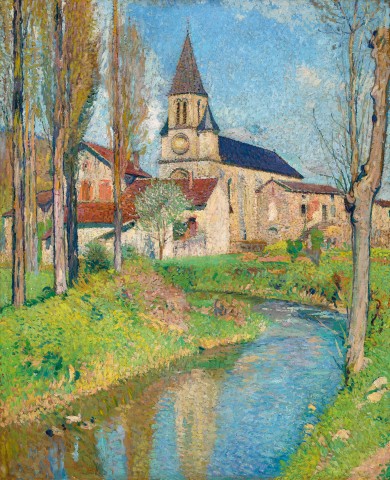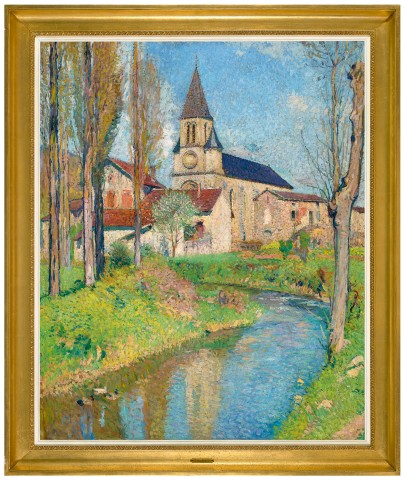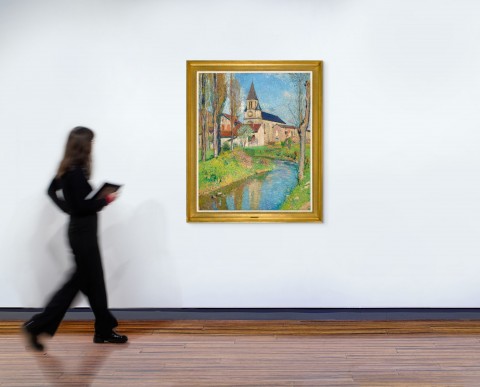L'ÉGLISE DE LABASTIDE-DU-VERT, c.1920s
HENRI MARTIN
oil on canvas
117.0 x 95.0 cm
signed lower left: Henri Martin
Private collection
Sotheby's, London
Private collection, Sydney, acquired from the above in the late 1990s
Thence by descent
Private collection, Melbourne
possibly: Galerie Georges Petit, Paris, c.1920 – 1926
possibly: Exhibition of French Contemporary Painting, Leicester Galleries, London, July – August 1927
Toulousian painter Henri-Jean Guillaume Martin’s early accolades at the École des Beaux-Arts de Toulouse facilitated a seamless entrance into artistic circles in Paris. There, the young Henri worked in the atelier of academic history painter Jean-Paul Laurens from the age of 19 and began exhibiting at the Salon des Artistes Français the following year. During this time, Martin produced grand Symbolist paintings, such as La Lutte des Titans contre Jupiter, 1884 – 85 (Museu Nacional de Belas Artes, Rio de Janeiro) whose positive reception at the Salon won the artist a formative travelling scholarship to Italy. Martin’s discovery of works by the masters of Italian Renaissance, in particular the frescoes of Giotto and Masaccio, radically changed his approach to painting. ‘After having seen Italy, I painted with love’,1 Martin wrote, his paintings now infused with brilliant light and displaying compositions of poetic lyricism. Crucially, at this point Martin also began to look beyond the classical techniques of his academic training – experimenting instead with the radical neo-impressionist technique of pointillism developed by Georges Seurat in 1884.
This peaceful village scene of L’Église de Labastide-du-Vert was painted during the 1920s in the free pointilliste style that brought Martin huge commercial success. Martin’s mosaic of unmixed parallel brushstrokes and the chromatic effects of their relative spacing creates a shimmering springtime view of the small village in the south of France where Martin lived until death in 1943. By the age of 40, the artist had tired of Parisian life, and searched for a residence in the ‘midi toulousain’, where he could spend half the year in the warm and sun-drenched countryside of his childhood. In 1900, Martin purchased a grand 17th century château of 28 hectares, Marquayrol (meaning ‘maison du rocher’ in local Occitan dialect), in the preserved medieval village of Labastide du Vert, in the Lot. The tranquil rhythms of this rural village, ordered by seasonal agricultural work, provided Martin with a limitless natural source of inspiration for his best works.
Perched high on a hill, Marquayrol’s terraced gardens offered the artist an incomparable sweeping view over the Vert valley, dotted with swaying poplars and ringed by purple peaks. The slow-moving tributary of the Lot River, the Vert, wends its way through the valley, snaking in a distinctive bend to the north of the town before passing under a double-arched drystone bridge a few meters from Labastide-du-Vert’s stone church, the Saint-Carissime. These three local landmarks: the sparkling iridescent stream, the bridge of local limestone where villagers would stop to chat, and the striking profile of the church’s campanile with its two successive rosettes, would become favourite subjects for Martin. Like Rouen Cathedral for Monet, Martin never tired of painting Saint-Carissime, capturing impressions of the building at different times of day and atmospheric conditions. This view of crisp springtime renewal was painted from the riverbank with a row of spindly poplars twinkling with spring buds and a trio of ducks in the foreground expertly described with a handful of brushstrokes of contrasting Prussian blue and pink. Martin has painted this scene in a spontaneous and assured manner, with small interstices of canvas left bare between brushstrokes. Confidently orchestrating the harmonies of bright meridional colours, Martin’s deft touches coalesce into this shimmering sublime bucolic scene.
1. Valmy-Baysse J., ‘Henri Martin’, Peinture d'Aujourd'hui, Paris, no. 5, 1910, cited in Juskiewensky, C., Henri Martin. Paysagiste et décorateur Languedocien, Thesis, Université de Toulouse, 1975
LUCIE REEVES-SMITH


